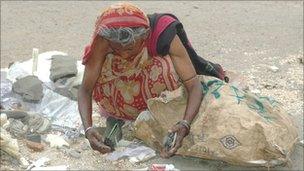Microcredit in Bangladesh 'helped 10 million'
- Published

Microcredit is predominantly offered to women to enable them to better control family finances
Microcredit lifted 10 million Bangladeshis out of poverty between 1990 and 2008, according to a report.
The work of Grameen Bank and others helped many families to raise their income above $1.25 a day, said the US-based Microcredit Summit Campaign, external.
The study follows recent criticism of microfinance, which works by providing small loans to people to invest in generating their own incomes.
Some experts argue the report may have missed the bigger picture.
They say the success stories are comparatively few compared to the overall number of borrowers.
'Progress'
The report drew on a survey of more than 4,000 households by the Economic Research Group in Dhaka.
Alex Counts of Grameen Foundation said: "This survey reminds us that even in difficult circumstances, major progress can be made."
Floods in 1998 and the food crisis of 2008 caused millions of families to fall below the $1.25 threshold.
However, even with these setbacks, nearly 10 million people rose above the poverty level.
But Dr Qazi Kholiquzzaman Ahmad, the chairman of PKSF which loans money to microcredit agencies in Bangladesh, says that his studies in 2006-2007 showed that only 7% of micro-borrowers were able to rise above the poverty line.
"Many borrowers remained where they were, while others suffered setbacks," he told BBC World Service's World Business News.
"In this latest study, only 10% of people have moved up, leaving the other 90% where they are. We cannot conclude that a whole lot has been achieved," he added.
Conflicting data
This news comes at a time when microfinance has come under close scrutiny over recent months.
Serious charges emerged about microfinance borrowers taking on multiple loans and too much debt, coercive collection practices by microfinance staff, and even suicides among borrowers who were unable to meet their payments.
India's multi-billion dollar industry was on the brink of a mass default until all the major banks in the country agreed to continue lending to microfinance firms.

There is no social network to help women who lose their husbands, so many are forced to beg
The evidence for microcredit lifting people out of poverty remains highly contested.
"Bangladesh is the capital of microcredit being used to tackle poverty," said Alun Doran at Oxfam, "but the numerous studies about its effectiveness are conflicting."
He said there was a distinction between poverty alleviation and poverty reduction.
Poverty alleviation involves mechanisms which can help people get out of poverty - and stay out.
"Secure savings are the preferred financial instrument rather than credit," Mr Doran maintained.
- Published3 November 2010
- Published16 December 2010